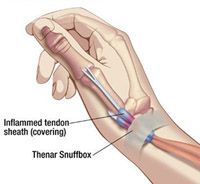
This is a series on arm and hand pain. If you missed the beginning, go back to the “Checklist of Causes.”
DeQuervain’s Syndrome (stenosing tenosynovitis) can produce a very painful condition at the wrist at the base of the thumb. (Stenosis refers to the narrowing of a canal or duct, tenosynovitis to inflammation of the synovial sheath of the tendon.) I have seen the inflammation so serious that it manifested as tiny pink dots all over the skin covering this prominent tendon.
DeQuervain’s Syndrome is caused by inflammation of the sheath that encloses two tendons of muscles that move the thumb. When the muscles are too tight, the tendons press outward on the sheath and rub against it, causing inflammation with repetitive motion and narrowing the space through which the tendons pass. Swelling also increases the friction of the two tendons rubbing against each other, adding to the inflammation. When the condition worsens, the inflammation results in calcification and soft tissue deterioration and becomes DeQuervain’s Disease. To prevent progression from syndrome to disease the muscles must be treated as well as the inflammed tendons.
 The two muscles involved are the long abductor and short extensor of the thumb. The abductor (abductor pollicis longus) moves the thumb away from the palm to separate the thumb and index finger. The short extensor (extensor pollicis brevis) moves the thumb away from the surface on which the hand may lie, back and away from that surface.
The two muscles involved are the long abductor and short extensor of the thumb. The abductor (abductor pollicis longus) moves the thumb away from the palm to separate the thumb and index finger. The short extensor (extensor pollicis brevis) moves the thumb away from the surface on which the hand may lie, back and away from that surface.
Conservative treatment involves first, icing the tendon at that part of the wrist for a few minutes at a time to decrease inflammation, swelling and pain while increasing blood flow. To create soft tissue healing, create change. Short applications of ice produce change, a flush of blood through the capillary beds that removes heat and the pain-causing waste products of inflammation.
Neuromuscular Therapy or deep treatment of the muscle bellies in the dorsal side of the forearm is necessary to release Trigger Points and muscle contractions that pull on the tendons. Sustained pressure to effect muscle release followed by “milking” the waste products from the tissues is effective. (Slow deep strokes toward the elbow.)
A stretch that will help. Remember that the muscles must move together to prevent rubbing of the separate tendons together. To do that, hold the thumb enclosed in a fist. Turn your fist to rotate the palm side out and the thumb side down. Cock your wrist toward the fleshy inner arm and then upward toward the pinkie side. Assist the motion with your opposite hand. Using Active Isolated Stretching protocol, actively stretch, assisting for two seconds, release and repeat 10 times. Ice for a few minutes before you stretch.

The next post will be about Repetitive Strain Injuries (RSI).